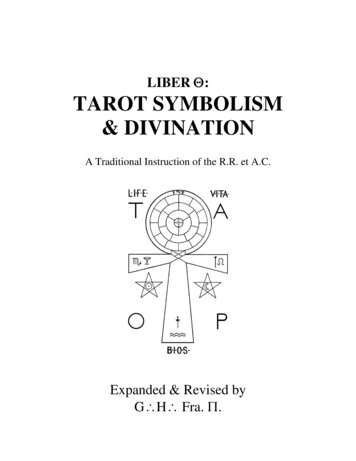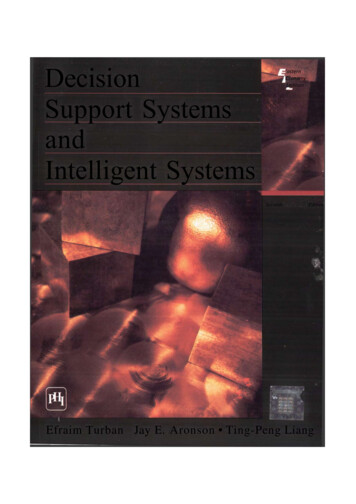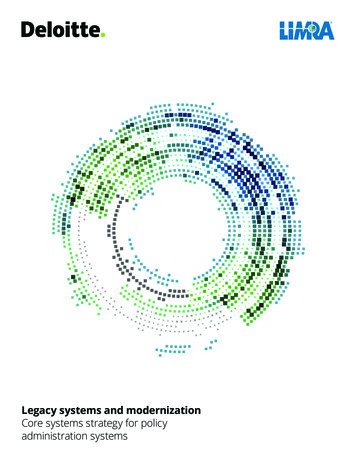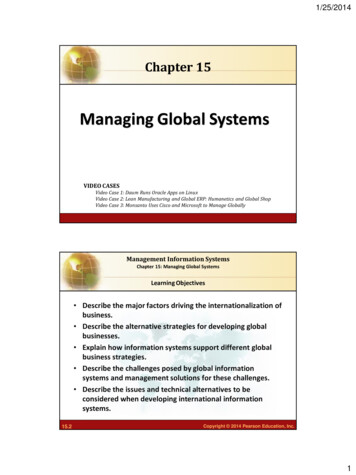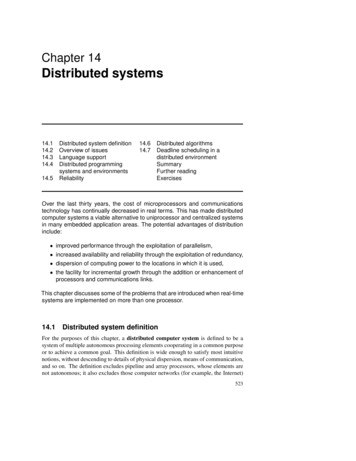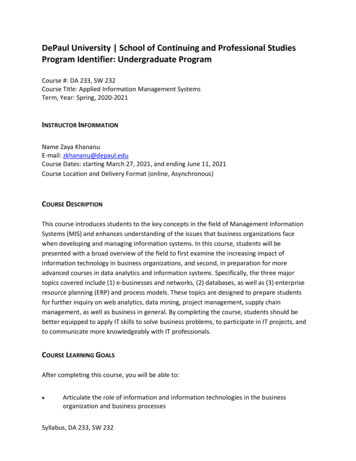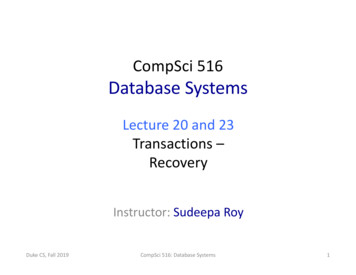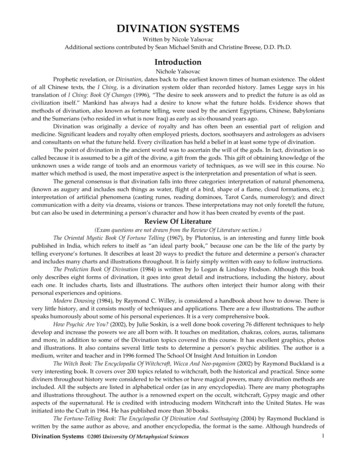
Transcription
DIVINATION SYSTEMSWritten by Nicole YalsovacAdditional sections contributed by Sean Michael Smith and Christine Breese, D.D. Ph.D.IntroductionNichole YalsovacProphetic revelation, or Divination, dates back to the earliest known times of human existence. The oldestof all Chinese texts, the I Ching, is a divination system older than recorded history. James Legge says in histranslation of I Ching: Book Of Changes (1996), “The desire to seek answers and to predict the future is as old ascivilization itself.” Mankind has always had a desire to know what the future holds. Evidence shows thatmethods of divination, also known as fortune telling, were used by the ancient Egyptians, Chinese, Babyloniansand the Sumerians (who resided in what is now Iraq) as early as six‐thousand years ago.Divination was originally a device of royalty and has often been an essential part of religion andmedicine. Significant leaders and royalty often employed priests, doctors, soothsayers and astrologers as advisersand consultants on what the future held. Every civilization has held a belief in at least some type of divination.The point of divination in the ancient world was to ascertain the will of the gods. In fact, divination is socalled because it is assumed to be a gift of the divine, a gift from the gods. This gift of obtaining knowledge of theunknown uses a wide range of tools and an enormous variety of techniques, as we will see in this course. Nomatter which method is used, the most imperative aspect is the interpretation and presentation of what is seen.The general consensus is that divination falls into three categories: interpretation of natural phenomena,(known as augury and includes such things as water, flight of a bird, shape of a flame, cloud formations, etc.);interpretation of artificial phenomena (casting runes, reading dominoes, Tarot Cards, numerology); and directcommunication with a deity via dreams, visions or trances. These interpretations may not only foretell the future,but can also be used in determining a person’s character and how it has been created by events of the past.Review Of Literature(Exam questions are not drawn from the Review Of Literature section.)The Oriental Mystic Book Of Fortune Telling (1967), by Plutonius, is an interesting and funny little bookpublished in India, which refers to itself as “an ideal party book,” because one can be the life of the party bytelling everyone’s fortunes. It describes at least 20 ways to predict the future and determine a person’s characterand includes many charts and illustrations throughout. It is fairly simply written with easy to follow instructions.The Prediction Book Of Divination (1984) is written by Jo Logan & Lindsay Hodson. Although this bookonly describes eight forms of divination, it goes into great detail and instructions, including the history, abouteach one. It includes charts, lists and illustrations. The authors often interject their humor along with theirpersonal experiences and opinions.Modern Dowsing (1984), by Raymond C. Willey, is considered a handbook about how to dowse. There isvery little history, and it consists mostly of techniques and applications. There are a few illustrations. The authorspeaks humorously about some of his personal experiences. It is a very comprehensive book.How Psychic Are You? (2002), by Julie Soskin, is a well done book covering 76 different techniques to helpdevelop and increase the powers we are all born with. It touches on meditation, chakras, colors, auras, talismansand more, in addition to some of the Divination topics covered in this course. It has excellent graphics, photosand illustrations. It also contains several little tests to determine a person’s psychic abilities. The author is amedium, writer and teacher and in 1996 formed The School Of Insight And Intuition in LondonThe Witch Book: The Encyclopedia Of Witchcraft, Wicca And Neo‐paganism (2002) by Raymond Buckland is avery interesting book. It covers over 200 topics related to witchcraft, both the historical and practical. Since somediviners throughout history were considered to be witches or have magical powers, many divination methods areincluded. All the subjects are listed in alphabetical order (as in any encyclopedia). There are many photographsand illustrations throughout. The author is a renowned expert on the occult, witchcraft, Gypsy magic and otheraspects of the supernatural. He is credited with introducing modern Witchcraft into the United States. He wasinitiated into the Craft in 1964. He has published more than 30 books.The Fortune‐Telling Book: The Encyclopedia Of Divination And Soothsaying (2004) by Raymond Buckland iswritten by the same author as above, and another encyclopedia, the format is the same. Although hundreds ofDivination Systems 2005 University Of Metaphysical Sciences1
divination methods are covered, the author attempts to give full explanations of each and how they are done. Healso mentions numerous famous or infamous people associated with divination. There are some charts,illustrations and photographs. Of the resources that I used, I feel this book is the best overall book on divination.Numerology Has Your Number (1988) by Ellin Dodge is an informative and precise book if you want todelve into numerology in detail. It is straightforward and well organized. The author is “America’s foremostNumerologist.”Charting the Future, Quest for the Unknown (1992), a Reader’s Digest Book, is a fascinating, coffee‐tabletype book with almost as many graphics, photos, charts and sketches as there are text entries. It is full ofinteresting historical facts and stories, and examines the theories behind the more popular methods of Divination.It covers astrology, augury, tarot, palmistry, dream interpretation, I Ching, time travel and much more.If you really want to learn all the aspects and details of Palmistry, The Art of Hand Reading (1996) by LoriReid would be an excellent book to have, especially since the entire book is about this subject. It contains clearand precise drawings, charts and photographs. It is easy to read and understand. The author is an expert palmistwho is consulted by people throughout the world, and has made numerous television and radio appearances.I Ching: Book Of Changes (1996), translated by James Legge, is considered to be the oldest surviving text inChinese culture. It has been use for the past three thousand years by various types of people, from philosophersand politicians and scientists to alchemists and sorcerers. Legge has translated the book in a very useable formatfor the English language reader.The Divining Rod (1975), by Arthur J. Ellis, is a short work, but actually gets right to the point. This bookmostly discusses the origins, case histories, and scientific controversies. This is a compilation done by the UnitedStates Geological Survey in 1917, trying to determine if it was worth government money to invest in using thistype of divination system for water, oil, minerals and other such substances. This book has a huge bibliography ofantiquated articles and books, dating back to 1532 AD. This book serves as an inexhaustible resource for thosewho wish to delve more deeply into the subject of the divining rod, or dowsing. If one wanted to find out all thathas been written since the 1500’s, this is the place to look.Reading The Past: Runes (1987), by R.I. Page, tells the story offerings from the earliest inscriptions, fromthe Vikings to Anglo‐Saxon times. Early civilizations used runes as a means of writing down history. It wasactually a very early language, not just a divination system. This book goes into runes as an alphabet rather than adivination system. Page is a professor of Anglo‐Saxon studies at the University of Cambridge. He has more bookson English and Norse runes, and other aspects of early English language and society. This book also had somefascinating pictures of ancient inscriptions in the language of runes.The Complete Illustrated Guide To Runes (1999, by Nigel Pennick is a very comprehensive book about runes.This book covers everything from how to cast and read the runes, how to use the runes in meditation, to runicyoga and runic numerology. No other book has been this creative and all the aspects that it covers around runes.Who would have thought of runic yoga? The author has studied the runes and practiced runic principles since1960. He has written numerous books and papers on European folk traditions, customs, and beliefs. His work istranslated into nine languages. He is the co‐founder of the esoteric magazine Arcana, and has appeared on radioand television shows in the U.K.The Beginnerʹs Handbook Of Dowsing: The Ancient Art Of Divining Underground Water Sources (1974) byJoseph Baum is a small but excellent book on dowsing. It gets right to the point, has very useful pictures and bythe end of this sure to read anyone would be able to begin to dowse for water in the various factions that aredescribed in this book. The author is a graphic designer, with a successful advertising agency in Hartford,Connecticut, but he is also an eminent dowser, well known for his proficiency in this process. He learneddowsing on his 130‐acre farm in the Berkshires.The Divining Rod: An Experimental And Psychological Investigation (1968), by William Barrett and TheodoreBesterman, looks at dowsing from a scientific point of view. This book is has played an important part in makingwater divining intellectually respectable. The late Barrett was a physicist and a chemist. Besterman is a successfuleditor, author, librarian and bibliographer. He served for many years as Investigations Officer of the Society ForPsychical Research in London. Their book makes a clear case for the reality of dowsing, and includes results oftheir thorough investigation of contemporary dowsers under closely controlled conditions. They show thatdowsing can be solidly grounded in scientific procedure. This book was originally published in 1926, and remainsa standard in the industry.Divination Systems 2005 University Of Metaphysical Sciences2
DIVINATION WITH DOMINOESFortune telling using dominoes is a relatively recent method. It was originally used extensively in Koreaand India and often combined with gambling. One source, The Oriental Mystic Book of Fortune‐Telling (1967) byPlutonius, claims the game of dominoes was invented in Italy in the 18th century. Another book by Jo Logan &Lindsay Hodson, The Prediction Book of Divination (1984) states that these tile‐like game pieces were originallyfrom China in the 12th century B.C. At that time the pieces were said to be white with red spots and consisted of32 pieces. By the time they migrated to Italy, the Domino game‐pieces became black with white round dots andthe complete set contained 28 rectangular pieces. It has remained consistently so since that time.The dominoes can be made of wood, ivory, bone, or ceramic. Each tile is divided by a straight line. Oneach side of this line is a set of dots, although one side might be blank. The dots are arranged in numbers fromone to six in different combinations.In order to read the dominoes, lay them face down, then select three tiles at random. Some sourcessuggest shuffling them until they are well mixed. Select one after each shuffle until there are three. Anothervariation of choosing is to lay them face down in various shapes, i.e. circles, oblongs or squares, but alwayschoosing just three tiles. There are differing opinions concerning the frequency of consulting the dominoes fordivination. Some feel it shouldn’t be done more than once in a week, others think no more than once in 28 days,but there is general agreement that excess use can reduce the power of the medium, which is true for all forms ofdivination. Once you have selected three dominoes, turn them face up to do the reading, In reading the threeselected dominoes, if one tile predicts loss and another tile promises prosperity, they cancel each other out.Therefore ignore their indications and read the fortune from the third tile. The meanings of each tile are asfollows:A six‐blank tile. Watch out for danger from water, avoid voyages at sea. Also be wary of gossip, scandaland treacherous friends. This domino could also indicate death in your group of friends or family.A six‐one tile. Foretells a wedding. Also warns of danger from fire. Pay attention to your health.Anticipate news, which could be good or bad.A Six‐two tile. This is a good time to start new projects, but with well thought out plans. Good luck isheaded your way if you are honest. Take advice from friends with a grain of salt.A six‐three tile. Indicates a positive travel experience, during which you may receive a gift. Happinesscoming your way. Also this tile is considered to be lucky for those in love.A six‐four tile. Expect success from speculation and investments. Watch out for disagreements on thedomestic front.A six‐five tile. Symbolizes friendship and a benefactor. Stick to a project you are working on. Beware ofsome troubles approaching.A double‐six tile. This tile is considered to be a very lucky one, the best one of all. The future holdshappiness and prosperity for you. Expect much joy, success and the realization of ambitions.A five‐blank tile. Decisions should not be made with haste. Keep a watchful eye on budgeting andcurbing selfishness. A crisis may be looming, proceed carefully, not impulsively.A five‐one tile. Surprising invitations or unexpected money are likely. Beware of possible financialdisappointment.A five‐two tile. A sign of a birth. Be wary of unexpected treachery from someone close to you. Be open tonew friendships.A five‐three tile. Currently your life is running smoothly. Donʹt pass up a good opportunity. Good newsand help from outside sources will come your way.A five‐four tile. Expect surprises, possibly a financial windfall. Take advantage of offers made to you.A double‐five tile. Indicates changes for t
It includes charts, lists and illustrations. The authors often interject their humor along with their personal experiences and opinions. Modern Dowsing (1984), by Raymond C. Willey, is considered a handbook about how to dowse. There is very little history, and it consists mostly of techniques and applications. There are a few illustrations. The author .
